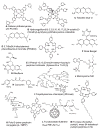Light based anti-infectives: ultraviolet C irradiation, photodynamic therapy, blue light, and beyond
- PMID: 24060701
- PMCID: PMC3831650
- DOI: 10.1016/j.coph.2013.08.009
Light based anti-infectives: ultraviolet C irradiation, photodynamic therapy, blue light, and beyond
Abstract
Owing to the worldwide increase in antibiotic resistance, researchers are investigating alternative anti-infective strategies to which it is supposed microorganisms will be unable to develop resistance. Prominent among these strategies, is a group of approaches which rely on light to deliver the killing blow. As is well known, ultraviolet light, particularly UVC (200-280 nm), is germicidal, but it has not been much developed as an anti-infective approach until recently, when it was realized that the possible adverse effects to host tissue were relatively minor compared to its high activity in killing pathogens. Photodynamic therapy is the combination of non-toxic photosensitizing dyes with harmless visible light that together produce abundant destructive reactive oxygen species (ROS). Certain cationic dyes or photosensitizers have good specificity for binding to microbial cells while sparing host mammalian cells and can be used for treating many localized infections, both superficial and even deep-seated by using fiber optic delivered light. Many microbial cells are highly sensitive to killing by blue light (400-470 nm) due to accumulation of naturally occurring photosensitizers such as porphyrins and flavins. Near infrared light has also been shown to have antimicrobial effects against certain species. Clinical applications of these technologies include skin, dental, wound, stomach, nasal, toenail and other infections which are amenable to effective light delivery.
Copyright © 2013 Elsevier Ltd. All rights reserved.
Figures





References
-
- Bell SG. Antibiotic resistance: is the end of an era near? Neonatal Netw. 2003;22:47–54. - PubMed
-
- Bush K, Courvalin P, Dantas G, Davies J, Eisenstein B, Huovinen P, Jacoby GA, Kishony R, Kreiswirth BN, Kutter E, et al. Tackling antibiotic resistance. Nat Rev Microbiol. 2011;9:894–896. An important review on the present state of antibiotic resistance and possible strategies to overcome the problem. - PMC - PubMed
-
- Gurzadyan GG, Gorner H, Schulte-Frohlinde D. Ultraviolet (193, 216 and 254 nm) photoinactivation of Escherichia coli strains with different repair deficiencies. Radiat Res. 1995;141:244–251. - PubMed
-
- Conner-Kerr TA, Sullivan PK, Gaillard J, Franklin ME, Jones RM. The effects of ultraviolet radiation on antibiotic-resistant bacteria in vitro. Ostomy Wound Manage. 1998;44:50–56. - PubMed
Publication types
MeSH terms
Substances
Grants and funding
LinkOut - more resources
Full Text Sources
Other Literature Sources
Medical
Research Materials

